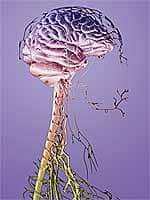Life Extension Magazine®
To the surprise of doctors around the world, melatonin is demonstrating life-saving benefits that far exceed its common use as a sleep aid.1 Increasingly, researchers have shown that melatonin’s impressive ability to control oxidative damage in systems throughout the body can reduce the trauma of brain injury, prevent heart muscle damage, offer neuroprotection, increase cognitive functioning, and reduce the toxic effects of chemotherapy while enhancing its benefits.2-7 Cumulatively, these findings add up to important new roles for melatonin not only in disease prevention but in almost every field of medicine. Much of the new evidence for melatonin’s versatile properties has been uncovered in just the past five years. As these findings continue to pour in, scientists are increasingly recognizing the wide ranging benefits of this remarkable hormone. Long thought to be solely the product of the tiny pineal gland in the brain and to be secreted only at night, melatonin is now known to be produced in multiple body sites. This powerful hormone impacts virtually every cell with which it comes into contact as well as being able to cross the highly selective blood-brain barrier.8,9 Derived from the amino acid L-tryptophan, melatonin’s molecular structure gives it some of the most impressive antioxidant capabilities known. These properties help to protect tissues that take the brunt of oxidative and other injuries, including the stomach, pancreas, and liver,5,10-13 as well as those most vulnerable to such injuries, like the brain and spinal cord.3,9 Melatonin also protects against cardiovascular diseases,7,14 degenerative brain diseases,15,16 brain injuries,17-20 stroke,21 and numerous cancers.2,22-24 Let’s take a closer look at some of the most impressive data on melatonin’s actions.25-27 Melatonin and InflammationMelatonin’s powerful anti-inflammatory effects are similar to those of commonly used non-steroidal anti-inflammatory drugs (NSAID) such as ibuprofen.28 Both NSAID drugs and melatonin inhibit an enzyme called cyclooxygenase-2 (COX-2) that produces inflammatory chemicals in the body. Unlike these drugs, however, melatonin has far fewer side effects because it does not inhibit the COX-1 enzyme that helps to protect the stomach lining.29 Furthermore, melatonin not only reduces pain perception in animal models of inflammation, but can also increase the analgesic effects of NSAID drugs.30 Earlier this year, researchers in New Zealand reported that, in addition to its anti-inflammatory properties, melatonin can promote a healthy immune response early in the process of wound healing, improving the quality of wound healing and scar formation.31 Studies like this are revealing much about melatonin’s ability to modulate the inflammatory process, not only in the important area of wound healing, but in other forms of tissue injury that occur throughout the body. Protection Against Brain InjuryBrain injury from stroke or trauma can quickly destroy one’s neurological function. Melatonin is showing important therapeutic benefits for this serious condition due its powerful free radical-scavenging and anti-inflammatory effects. All types of serious brain injuries—including traumatic brain and spinal cord injury, ischemia/reperfusion due to atherosclerosis, and neurodegenerative diseases—involve dangerous oxidant stress and inflammation. While overt head trauma is most common in children and young adults, older adults also suffer from the same kinds of damage caused by chronic reductions in brain blood flow due to atherosclerosis, and to sudden interruptions in blood flow during a stroke. In both traumatic head injuries and in strokes, most of the damage is done when blood flow returns to areas that have been transiently deprived. The resulting ischemia/reperfusion injury releases waves of oxygen and other free radicals that literally “burn” cell membranes and impair function.32,33 A tremendous amount of attention is therefore focused on preventing the consequences of that oxidant release—something melatonin can do with remarkable efficiency.3,9,20,34,35 Swiss neurologists showed that mice treated for 30 days with melatonin 24 hours after an experimentally induced stroke had improved survival of brain cells and better recovery of injured cells.21 These changes were associated with long-lasting improvement of motor and coordination deficits (both common after human strokes). Levels of melatonin, a potent neuroprotective agent,16 drop sharply in patients who suffer severe head injury.36 Animal studies have found that replenishing melatonin levels after head injury prevents both detectable tissue injuries and the cognitive deficits they produce.19
Laboratory studies worldwide have revealed that, in addition to its free radical-scavenging ability, melatonin reduces chemicals produced by brain cell oxidation,34,37 increases levels of other natural antioxidants such as vitamin C,18 and decreases activation of inflammatory systems in brain cells.38 These antioxidant effects are now credited with reducing the size of brain contusions (bruising) following head trauma.39 What is even more remarkable is melatonin’s ability to prevent the devastating cognitive outcomes of severe head injury. Turkish researchers studied damage to the hippocampus, a brain region known to be essential for proper memory function. They found that melatonin given immediately after head injury in rabbits not only reduced visible injury to the hippocampus, but actually improved memory deficits that prevented the animals from performing well in a maze.40 Melatonin has also been found to protect fetal animals from ischemia/reperfusion injuries that occur during pregnancy.35 These injuries can occur late in human pregnancies and are responsible for tragic consequences such as cerebral palsy and mental retardation in newborns. Studies have shown that melatonin prevents newborn learning disorders associated with brain injury in infant animals41 and that repeated doses of melatonin reduce injury even further.42 Scientists at Life Extension-funded laboratories long ago recognized the ability of melatonin to protect the brain against reperfusion injury. In experiments designed to see how long animals could survive at low temperatures with no blood flow, melatonin administered prior to surgery greatly extended the time that animals could undergo complex procedures and still recover.
Preventing Neurodegenerative DiseasesDramatic advances have revealed that melatonin prevents many cognitive deficits associated with aging. This is especially because of melatonin’s ability to cross the blood-brain barrier and its ready absorption following oral dosing.3 A recent human study assessed the benefit of melatonin in 50 sufferers of mild cognitive impairment (MCI), a collection of conditions that precedes dementia and Alzheimer’s disease.43 After giving melatonin 3-9 mg daily at bedtime for 9-18 months to half of the study group, researchers found that the supplemented patients had significantly better performance on a host of neuropsychological tests while experiencing improvements in sleep quality and wakefulness.
Scientists have also discovered promising effects of melatonin on the amyloid-beta proteins that trigger inflammation and brain dysfunction in Alzheimer’s disease.44 Very low doses of melatonin given for 10 days substantially improved learning and memory in animals as well as reducing levels of inflammatory proteins. Of course, not all deficits in cognition and memory are related to Alzheimer’s disease. Melatonin also seems to optimize brain cognitive function in the course of natural aging. One recent study, for example, found that daily administration of melatonin in drinking water at night significantly improved memory in aging animals tested on a maze, but had no effect on learning in young adult rats.26 And early human trials suggest that melatonin might provide benefits in degenerative disorders such as amyotrophic lateral sclerosis (ALS or Lou Gehrig’s Disease), in which motor function, not cognition, is lost.45 CardioprotectionMelatonin is getting a lot of attention as a potential cardioprotective nutrient.46 As with its effects elsewhere in the body, melatonin efficiently scavenges free radicals produced during cardiac injury, while increasing antioxidant enzymes. These powerful anti-inflammatory actions prevent further oxidative damage and limit the size of an infarction (area of heart cell death).7,47 Melatonin also improves the strength of the heart’s pumping action following an infarction in laboratory animals48 and can even prevent heart muscle damage following potent cardio-toxic chemotherapy treatment.49,50 In addition, laboratory studies have demonstrated that melatonin protects mitochondria (the energy sources so vital to cardiac muscle function) during ischemia and reperfusion.51 Its effects on heart muscle are both short- and long-lived, potentially preventing heart attacks and minimizing their impact if they do occur.52 In a study of patients with stable narrowing of their coronary arteries, who are at risk for ischemic events (angina and heart attacks), researchers compared melatonin with conventional medical therapy with isosorbide dinitrate (Isordil®) and also tested the combination of both treatments.53 Sixty-five patients aged 44-69 were studied by echocardiography to evaluate heart wall motion and function. The findings revealed that patients who received melatonin plus drug treatment had significantly greater increases in heart muscle function than those on drug treatment alone as well as a beneficial decrease in heart size and increase in the amount of blood actively ejected from the heart with each beat.53 A large prospective randomized trial is now getting underway in Spain to determine whether melatonin treatment reduces infarct size, deaths, abnormal heart rhythm, shock, heart failure, and other potentially disastrous consequences of a heart attack.46
Melatonin has also been shown to regulate specific risk factors for cardiovascular diseases. Night-time hypertension is a known cardiovascular risk factor—people who don’t “dip” (safely decrease) their blood pressure at night are more likely to have cardiovascular events than those who do.54 In a recent study, 38 people (mean age 64 years) with night-time hypertension who were already receiving stable antihypertensive therapy, were given either controlled-release melatonin, 2 mg/night, or placebo two hours before bedtime for four weeks.55 The supplemented patients significantly reduced their nocturnal blood pressure (136 to 130 mmHg systolic, and 72 to 69 mmHg diastolic), while no difference was seen in the placebo group.55
A heart attack can also be triggered by stress-induced increases in blood-clotting tendency that are amplified by hypertension.56 Swiss researchers recently discovered that melatonin may influence blood clotting. They found that a single dose of oral melatonin (3 mg) given to a group of 46 healthy young men significantly reduces overall blood coagulation activity compared with placebo.57 These scientists also found that melatonin attenuates the stress-induced procoagulant response to acute psychosocial stress, a potent trigger of acute coronary disease, in the same group of healthy men.58 Gastrointestinal Tract ProtectionThe human gastrointestinal tract is the site of some of the most profound oxidative stresses our bodies experience, which may be why it produces more than 500 times as much melatonin as the pineal gland.59 The stomach takes the brunt of the damage because of its constant exposure to strong acid and/or powerful digestive enzymes, both of which generate “storms” of free radicals. Melatonin not only reduces stomach injury caused by NSAIDs such as piroxicam or indomethacin by as much as 90% compared with controls, but also dramatically reduces measures of tissue oxidation with no significant adverse effects.60,61 European researchers have also shown that melatonin protects against damage to both the stomach and the pancreas and accelerates healing of chronic gastric ulcers by stimulating blood flow.5,10 Further research from Europe has revealed that melatonin reduces symptoms in patients with another painful condition called “functional dyspepsia,” or “sour stomach.”62 In a placebo-controlled trial, gastroenterologists treated 60 patients (aged 19-39 years) with functional dyspepsia with either melatonin 5 mg or placebo, once every evening for 12 weeks. Of the melatonin-treated group, 57% showed complete resolution of symptoms and 30% had partial improvement, but 93% of placebo recipients reported no change at all.
Melatonin has also been studied in alleviating gastroesophageal reflux disease (GERD, also known as “heartburn”), a potentially dangerous condition that can lead to esophageal cancer. In a head-to-head comparison, the researchers gave 175 patients standard treatment with the prescription drug omeprazole (Prilosec®), while 176 received a supplement containing melatonin, its precursor L-tryptophan, and B vitamins, over a 40-day treatment period. All patients in the supplement group reported complete regression of symptoms by the end of the study, compared with only 66% in the drug-treated group. Again, no significant side effects were reported in the supplemented patients.63 It is believed that melatonin protects against GERD by increasing blood flow and anti-inflammatory molecules in the esophageal mucous, thus preventing significant esophageal injury.64 Cancer Prevention and ControlCancer, of course, is one of the most-dreaded final outcomes of lifelong exposures to oxidant stresses and the inflammation that can damage the body’s DNA. For patients undergoing anticancer therapies, melatonin is at the forefront of cancer immunotherapy (treatment and prevention of cancer using the body’s own immune system as an ally) by working synergistically with several of the body’s own anti-tumor systems and dramatically decreasing adverse effects of treatment.22 Much of the remarkable work in this area has come from the prolific group of researchers led by Dr. Paolo Lissoni, a radiation oncologist in Milan. In 1992, Dr. Lissoni broke new ground by providing melatonin at a dose of 10 mg/day to a group of patients with metastatic lung cancer.65 This group of patients, who had already failed chemotherapy, was randomly assigned to receive melatonin or supportive care only. Survival at one year and stabilization of disease were both significantly higher in the melatonin-treated group. Not only were there no drug-related toxic effects, but melatonin-treated patients actually showed a significant improvement in their overall performance status.
Subsequently, Dr. Lissoni’s group demonstrated that they could improve the tumor-killing power of the cytokine interleukin-2 (IL-2) by supplementing patients with 40 mg/day of melatonin beginning a week prior to treatment—again without side effects even at this substantial dose.66 By 1999, Dr. Lissoni’s group had progressed to a study of 250 patients with tumors that had metastasized.67 Subjects received melatonin 20 mg/day plus chemotherapy, or chemotherapy alone. This was a large group of patients with cancers in a variety of tissues, and who received a variety of chemotherapy regimens. Even in this very diverse group of patients, the melatonin-treated subjects had significantly higher one-year survival and greater tumor regression rates than those who received chemotherapy only. In addition, those supplemented with melatonin experienced far fewer episodes of chemotherapy-associated toxicity such as low platelet counts, neurotoxicity and cardiotoxicity, and mouth sores. Devotion to improving the lives of cancer sufferers has led Dr. Lissoni and colleagues to continue to explore melatonin’s dramatic effects in patients with some of the most advanced cancers, with a steady stream of positive reports continuing up to the present moment.23,24,68-70 US researchers in Texas have found that melatonin also reduces prostate cancer cell growth rates,71,72 and other researchers from around the world are beginning to take notice. We can confidently predict that melatonin will play an increasingly important role in both the treatment and the prevention of cancer as we learn more about its remarkable properties.
SummaryMost experts believe that we are seeing just the tip of the iceberg represented by melatonin’s versatile, system-wide effects. This formerly “niche” hormone, long thought to be responsible only for day-night cycling and important effects on sleep, is turning out to be the “dark horse” of biomedicine in the early 21st century. We’ve seen how melatonin’s intense antioxidant activities, remarkable ability to modulate the immune system, and capacity to manage inflammatory consequences of tissue injury throughout the body are leading to its use in just about every conceivable setting. From the tragic consequences of severe head trauma to the neurological deficits experienced by Alzheimer’s and stroke patients, to the deadly effects of advanced cancers, melatonin has shown that it has important wide-ranging applications for medical treatment. If you have any questions on the scientific content of this article, please call a Life Extension Wellness Specialist at 1-800-226-2370. | ||||||||||||
| References | ||||||||||||
|






